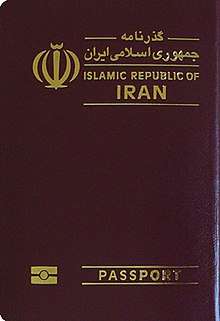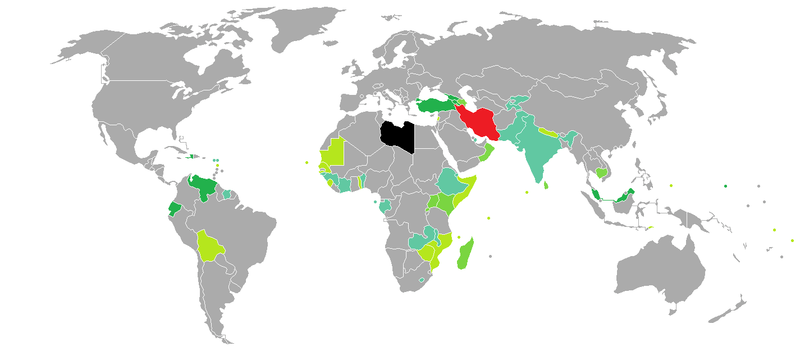Iranian passport
Iranian passports, also known as Persian passports, are issued to nationals of Iran for the purpose of international travel. The passport serves as a proof of Iranian citizenship. The Iranian passports are burgundy, with the Iranian Coat of Arms emblazoned on the top of the front cover.
| Iranian passport | |
|---|---|
 The front cover of a contemporary Iranian biometric passport. | |
| Type | Passport |
| Issued by | |
| First issued | c. 1925 (original) 1979 (current version) January 1, 2007[1] (biometric passport) |
| Purpose | Identification |
| Eligibility | Iranian nationality law (Provided that men perform compulsory military service.) |
| Expiration | 5 years after issuance (for adults over 18) |
| Cost | 1,500,000IRR (~10 US Dollars) |
The words "جمهوری اسلامی ایران" (Persian) meaning Islamic Republic of Iran and "گذرنامه" (Persian) meaning passport are inscribed to the right side of the coat of arms. Iran started issuing diplomatic and service biometric passports in July 2007. Ordinary biometric passports began to be issued on 20 February 2011. These passports contain 32 pages.
On the inside of the back-cover, Iranian passports bear the inscription: "The holder of this passport is not entitled to travel to occupied Palestine", referring to Israel.[2]
In the past, prior to the Islamic Revolution of 1979, the passports were different and had the inscription 'Empire of Iran', as shown below. The passports also had translations into French.
Identity information page
The Iranian passport includes the following data:
- Holder's signature / امضا دارنده گذرنامه
- Country of residence / کشور محل اقامت
- Place of Issue / محل صدور پاسپورت (The exact place of the passport's issuance. e.g. 'Yerevan' if it's issued outside of the country, or 'Immigration and Passport Police' if it have been issued inside)
- مدرک صدور گذرنامه (an Eight Digit Code showing the Passport's number)
- Name & Position of Issuing Authority (or, in the older passports, "Name & Position of Issuing Officer) / نام و سمت صادر کننده
- ملاحظات (Does not exist in the Passports that have issued within the country borders. It states the last exact time of exiting Iran.)
- Type ('P' for passport)
- Country Code (IRN)
- Passport No. (in older passports: "Passport Number")
- شماره ملی (National ID number)
- Surname / نام خانوادگی
- Name / نام
- Father's Name / نام پدر
- Date & Place of Birth / تاریخ و محل تولد (Example: 1970-01-01 - TEHRAN or ۱۳۴۸/۱۰/۱۱ - تهران)
- Sex / جنسیت (M/مرد for male, F/زن for female)
- Date of Issue / تاریخ صدور
- Date of Expiry / تاریخ انقضا
- شماره شناسنامه (Either, the old Birth Certificate number (for those who have born before 1990), or a repetition of the National ID number.)
Passport number
The passport number is the serial number that uniquely identifies a passport. The passport number changes every time a person has issued a new passport, with the previous passport number noted in an endorsement on the last page of the new passport.
The passport number is alphanumeric, with a letter followed by an eight-digit number, e.g. A00000000. In the Persian letters on top of the passport, the passport number does not have the first English letter.
Identity Number
The national identity number for Iranians is a unique 10-digit number allocated to each citizen of Iran; & it is used widely for identity confirmation in many places. The unique number is in the following format:
XXX-YYYYYY-C
- The first three digits are the numeric code indicating the state of birth.
- The next six digits are randomly generated numbers
- And the last digit is known as the Check or Control Number.
The control number is calculated from the previous 9 digits and verifies if the ID number is valid.
Languages
For each item in the passport captions are provided in Persian and near all of them are also provided in English.
Restrictions on travel
As Iran (the Islamic Republic of) does not recognize nor have diplomatic relations with the state of Israel (like some other Muslim countries), people using an Iranian passport are not permitted to travel to Israel under Iranian law (although Israel itself does admit Iranian citizens holding a visa). On the inside of the back-cover, Iranian passports bear the inscription: "The holder of this passport is not entitled to travel to occupied Palestine", referring to Israel.
Visa requirements for Iranian citizens
As of 26 August 2017, Iranian citizens had visa-free or visa on arrival access to 39 countries and territories, ranking the Iranian passport 95th in terms of travel freedom according to the Henley visa restrictions index.[3]

Earlier in 2017, Donald Trump (President of the United States of America) banned citizens of Iran from the US; he also has banned people that travel to Iran. (See Trump travel ban)
History

The first Persian passport was issued during the reign of Nasereddin Shah around 1885.[4] It used to be called 'Tazkereh-ye Safar' (Travel Document) and the text was entirely in Persian. During the reign of Ahmad Shah (early 20th-century) the French titles were added to the document "Passeport du passage: au nom de Sa Majeste Imperiale le Shahinschah de Perse" (Passport of the Passage: in the name of His Imperial Majesty the Shahanshah of Persia). After 1935 the title was changed to "Empire de l'Iran".
Gallery of historic images
 Iranian Passport/Empire Passport from 1975
Iranian Passport/Empire Passport from 1975 Empire Passport Cover.
Empire Passport Cover. Empire Passport - 'Rules to be observed by passport bearer' (French language).
Empire Passport - 'Rules to be observed by passport bearer' (French language). Iranian Passport Datapage
Iranian Passport Datapage Iranian Passport DataPage (2017)
Iranian Passport DataPage (2017)
See also
- Iranian national identity card
- Visa requirements for Iranian citizens
- Visa policy of Iran
- Iranian nationality law
- List of passports
References
- "Council of the European Union - PRADO - IRN-AO-03001". Consilium.europa.eu. 2011-10-25. Retrieved 2020-06-02.
- Moaveni, Azadeh (1 June 2009). "Roxana Saberi and How Journalism Works in Iran". Time. Time Inc. Archived from the original on 25 January 2010. Retrieved 25 January 2010.
Israel also figures into the peculiar regulations Iranian journalists must contend with. The fine print of my Iranian passport clearly states that the bearer of this passport is forbidden from traveling to occupied Palestine."
- "Global Ranking - Visa Restriction Index 2017" (PDF). Henley & Partners. Retrieved 14 March 2017.
- "Persian passport in Qajar and Pahlavi eras". Jaam-e Jam Daily. Retrieved 7 July 2020.
External links
- Ministry of Foreign Affairs of Iran
- Iranian Interests Section at Pakistani Embassy (Washington D.C.)